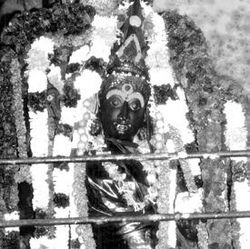By Swami Harshananda
Bhadrakāli literally means ‘the Auspicious Kālī’. Depending on the scripture, she is referred to an aspect of Pārvati, Durgā, or the female companion of Vīrabhadra.
Aspect of Pārvati[edit]
Worship of God as Mother has been in vogue since ancient times. Out of the several aspects of the Mother Goddess that are still worshiped, an overwhelming majority are the forms of Pārvati or Śakti, the consort of Śiva. Bhadrakālī is also one of them.
Since ‘bhadra’ means auspiciousness, Bhadrakālī is a pleasing deity with a charming appearance. She is depicted as seated on a chariot drawn by four lions. She has eighteen hands in which she carries things such as rosary, trident, sword, shield, bow and arrow, conch, discus, sacrificial ladles, holy water-pot, spear and so on. One of the hands is raised in the gesture of benediction.
Aspect of Durgā[edit]
The Kālikāpurāna[1] however describes Bhadrakālī as an aspect of Durgā, and as an exceedingly terrible deity.
- The demon Mahiṣāsura saw her in dream and was stricken with mortal fear. He worshiped her and got the boon to be killed directly by her. She also granted an additional boon that he too would be worshiped in future along with her.
- The girl-child of Yaśodā which was brought to the prison by Vasudeva, the father of Kṛṣṇa, after exchanging it with baby Kṛṣṇa, and which Kamsa tried to kill, was also Bhadrakālī.
Female companion of Vīrabhadra.[edit]
According to another account Bhadrakālī was the female companion of Vīrabhadra, who was created by Śiva out of a hair from his matted locks to destroy Dakṣa’s sacrifice.
References[edit]
- ↑ Kālikāpurāna chapter 59
- The Concise Encyclopedia of Hinduism, Swami Harshananda, Ram Krishna Math, Bangalore


